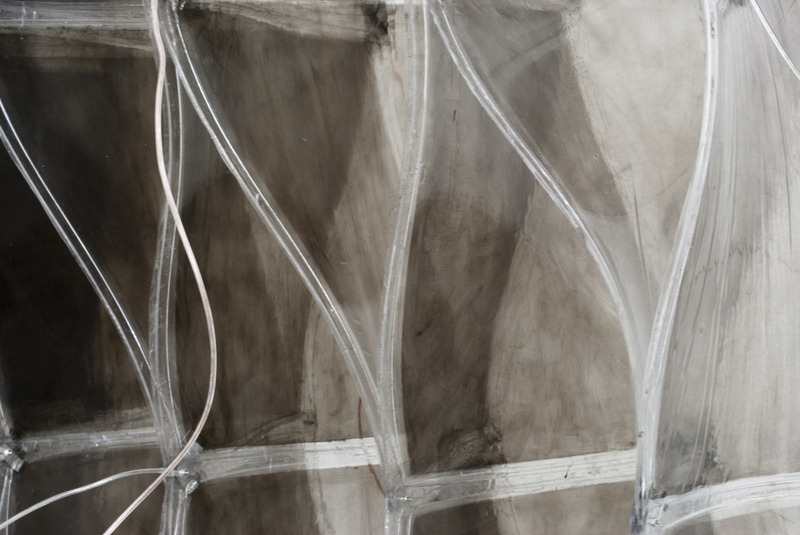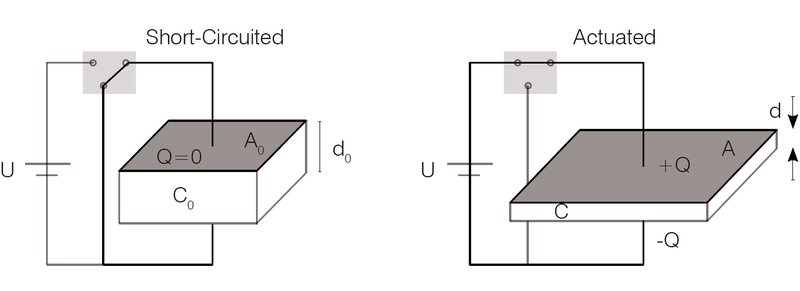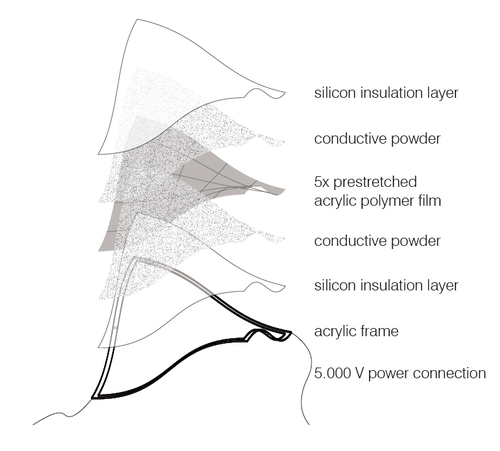
EAP is a polymer actuator that converts electrical power into kinetic force. Due to its extreme flexibility, lightness, transparency, thin dimensions and its ability to smoothly change shape it is a highly attractive component for architectural solutions.
ShapeShift
By Manuel Kretzer and Edyta Augustynowicz and Sofia Georgakopulou and Dino Rossi and Stefanie Sixt

The component based form results from the material’s desire to return into its original shape combined with specially designed structural frames developed to allow an appropriate degree of flexibility.

Through direct component-to-component linkages an added layer of complexity is achieved. Each entity has an influence on the form and movement of its neighbors, and therefore, on the structure as a whole.

EAP working principle: After application of high voltage the elastomeric film is compressed and expands in area.

Different layers of membrane components (from top to bottom: silicon insulation, conductive powder, pre-stretched polymer film, conductive powder, silicon layer, acrylic frame, 5 kV power connection)

Early investigations focused on static supporting structures, but after a number of experiments, the interest moved towards developing dynamic structural configurations. In these dynamic systems no static backbones are necessary, rather, individual components are connected to each other to produce self-supporting forms.























13936 Comments – Login to comment
brigadekomaralahights · Sep 6, 21 9:04 am
Brigade Komarla Heights is a gated residential community developed by Brigade Group and is coming up in scenic and homely locale of Sy No: 74/2B, 75, 78/2, 78/4 Chikkalasandra Village, Uttarahalli Hobli Subramanyapura Main Road, South, Taluk, Bengaluru, Karnataka 560061https://www.brigadekomarlaheights.org.in/
brigadekomaralahights · Sep 7, 21 7:59 am
Prestige Avalon Park Bangalore, Property options for all budgets abound in the Sarjapur area. Fair property prices are another explanation for the rise in demand. Some of the area's top developers include Puravankara, Sekhar Constructions, Sobha Limited, Salarpuria Group.Visit : https://www.prestigecityavalonpark.in/master-plan.html
brigadekomaralahights · Sep 7, 21 8:00 am
Property options for all budgets abound in the Sarjapur area. Fair property prices are another explanation for the rise in demand. Some of the area's top developers include Puravankara, Sekhar Constructions, Sobha Limited, Salarpuria Grouphttps://www.prestigecityavalonpark.in/
prestigeavalonpark · Sep 7, 21 8:00 am
Buying your future property in this region of Bengaluru could be a worthwhile investment, considering the area's potential growth opportunities. Accessibility, and also some access to social services and affordable pricing, is the key USPshttps://www.prestigecityavalonpark.in/
prestigeavalonpark · Sep 7, 21 8:01 am
Prestige Avalon park Bangalore, It's time to bring your capital into the properties which have been bought here, with Sarjapur Road becoming one of the most sought-after https://www.prestigecityavalonpark.in/qazqwerty · Sep 14, 21 4:39 am
Czas pomy?le? o swoim instagram follow i zakupi? pakiet followersów ju? dzi? w niezwykle atrakcyjnej cenie.qazqwerty · Sep 14, 21 4:41 am
https://fameboosters.pl/https://www.followersy.pl/produkt/instagram-obserwujacy/
https://kupobserwujacych.pl/
https://www.echtefollower.de/produkt/ig/
qazqwerty · Sep 14, 21 4:42 am
I think this is the best site and I will encourage everyone to visit this site. I think it's already ver popular but still there might be people who don't have any idea about this site. https://www.followersy.pl/produkt/instagram-obserwujacy/qazqwerty · Sep 14, 21 4:44 am
I can see that this webpage is amazing and lovely and I enjoy reading it. I actually read and check this webpage every day before I go to sleep. https://fameboosters.pl/qazqwerty · Sep 14, 21 5:03 am
I think that this page is interesitng and great and I will recommend it to my friends and family to check this page too becaise it's so incredibly interesting https://www.echtefollower.de/produkt/ig/qazqwerty · Sep 14, 21 5:04 am
I enjoy reading this page because it's interesting and I am glad that I was able to find this page https://kupobserwujacych.pl/birlatisya · Oct 7, 21 5:45 am
Birla Tisya is an high rise apartment coming up in Magadi main road, Rajajinagar, Bangalore.https://www.birla-tisya.co/
https://www.birla-tisya.co/floor-plans/
https://linktr.ee/tisyabirla
godrejparkretreat · Oct 7, 21 9:20 am
Project Godrej Park Retreat features elevated housing towers hosting luxury and ultra-luxury apartments and villaments of various size ranges and price spectrums. 1 BHK, 2 BHK and 3 BHK abodes of varying dimensions and phasing are offered to the investors.https://godrejsparkretreat.in/
theprestigecity. · Oct 9, 21 6:32 am
Palatial suburbs of East Bangalore just off Sarjapur Main Road close to all essentials amenities and facilities. This area lies in close precinct to prime commercial hubs of Marathalli, Whitefield, Electronic City and Koramangala.https://www.prestigecity.gen.in/
theprestigecity. · Oct 11, 21 6:03 am
https://www.prestigecity.gen.in/Has succeeded in providing the customers with their requirements when it comes down to plots or apartments, at any given season.
prestigecity · Oct 11, 21 6:39 am
https://www.edocr.com/v/eep6rd3q/prestigecitybangalore/the-prestige-city-bangalorehttps://www.quora.com/How-long-has-the-house-been-on-the-market-and-what-is-the-expected-price-3?top_ans=311269431
https://www.hotfrog.in/company/1480084902821888/the-prestige-city/bangalore/real-estate-services
https://slashdot.org/submission/14692373/prestige-city-apartments-in-bangalore
https://www.deviantart.com/prestigecitybangalor
https://www.brownbook.net/business/50036339/prestige-city
https://www.expatriates.com/cls/48935018.html
https://www.slideserve.com/27223/the-prestige-city-bangalore-powerpoint-ppt-presentation
https://www.slideshare.net/prestigecity1/prestige-city-aspen-greens
https://angel.co/u/prestige-aspen-greens
https://sites.google.com/view/prestigeaspengreens-bangalore/home?authuser=7
https://theprestigecityblogs.wordpress.com/
https://gust.com/companies/prestige-city-aspen-greens
https://www.tripoto.com/trip/prestige-aspen-greens-615ac02a7c559
https://trello.com/c/wflX4Yp4
https://www.yumpu.com/en/document/view/65894823/prestige-city-aspen-greens
prestigegroup · Oct 11, 21 11:15 am
This New launch villa project in Bangalore has a development size proposed to be over 12 million square feet spread across 100+ acres of total land. With Over 140+ villas of G=1 floor each.
Prestige Group, one of the top and dynamic real estate developers with some impeccable properties to its credit across the city, now presents The Prestige City, a premium residential villa property in Sarjapur Road of the notable locations of Bangalore.
This expansive villa project with a varied mix of residences is expected to have a launch date in the second quarter of 2021.
Sarjapur Road in east Bangalore is a rapidly developing real estate hub with many Information technology parks. With these pre-launch luxury villas in Sarjapur road, Prestige will create another landmark.
https://commaful.com/play/cityprestige/prestige-city-is-a-upcoming-plots-villas--apartmen/
https://unsplash.com/@cityprestige
https://www.producthunt.com/@cityprestige
https://coub.com/cityprestige
https://www.speakingtree.in/prestige-group-1
https://prestigecitys.bandcamp.com/album/prestige-city
https://app.process.st/workflows/Prestige-City-qnj-HMnOQjTiemIm_upAIQ/view/tasks/lMs-CUxSRyK5c2XRoqF...
https://www.yumpu.com/en/document/view/65891345/prestige-city
https://kontactr.com/form-page/ea9faf25b898691
https://dribbble.com/shots/16567645-Prestige-City?added_first_shot=true
https://www.powershow.com/view0/938367-MWUxM/Prestige_City_powerpoint_ppt_presentation
https://sq.wikipedia.org/wiki/P%C3%ABrdoruesi:PrestigeCitys
brigadekomarla · Oct 12, 21 11:45 pm
Brigade Komarla Heights offers a host of recreational, entertainment, community and sports services to take pleasure in on. The services supplied at Brigade Komarla Heights consists of an impactful club, inward swimming area, cafe, healthiness centre.https://www.brigadekomarlaheights.org.in
prestigecity1 · Oct 13, 21 12:32 am
The Prestige City metropolis is getting geared-up for its launch with all essential clearances and RERA approvals and might be quickly made to be had for booking.
https://www.prestigecity.gen.in/
https://www.facebook.com/photo/?fbid=102340968883514&set=a.102341928883418
https://twitter.com/theprestige_c/status/1441331107228651530?s=20
prestigeavalonpark1 · Oct 13, 21 1:03 am
The abodes are arrayed over well dependent high-rise towers set amidst the foothills of manicured outside and inexperienced orbits. Prestige Avalon Park ensures to be a harbour of affluence,https://www.prestigecityavalonpark.in/
godrejparkretreattown · Oct 13, 21 1:32 am
The concern’s goods development portfolios amplify to retail, business and household endeavours. The agency operates in united countries of america’s primary cities like Bangalore, Ahmedabad, Chennai.https://www.godrejsparkretreat.in/
prestigecity · Oct 13, 21 5:20 am
Godrej Park Retreat Apartment is the best place to escape from urban chaos and move to the place where everything is dream-like and perfect. This place offers breathtaking beauty and serene surroundings. Godrej Park Retreat is loaded with world-class amenities. A multi-purpose hall, library, senior citizen zone, landscaped gardens, water features, uninterrupted power & water supply, high-speed lifts etc. are few from the list.https://godrejsparkretreat.in/
https://www.producthunt.com/discussions/godrej-park-retreat-apartments-in-bangalore
https://www.instructables.com/Godrej-Park-Retreat-Bangalore/
https://www.callupcontact.com/b/businessprofile/Godrej_Park_Retreat/7850026
https://coub.com/view/2wmedi
prestigecity · Oct 18, 21 2:16 am
Prestige Avalon Park is a gated residential community within the majesticity of ‘The Prestige City’, an integrated ‘township’ venture by Prestige Groups coming up in serene and palatial surrounds of Sarjapur Road in South East Bengaluru. Prestige Avalon Park is a part of 180 acres - project with dedicated boundaries for ultra-luxury low density premium apartments arrayed over high rise structures towered amidst the goodness of contemporary amenities, nature friendly environs and all essentials. The community features luxurious, plus size 3 and 4 bed apartments drafted to perfection for an expansive, admirable and upscale livelihood. The 3 Bedroom apartments are classified as 3 Bed – Classic and 3 Bed – Premier and 3 Bed Ultima. The Super Built up area of 3 Bedroom – Classic apartment is 1361 Sq feet / 126.42 Sq Metres and carpet area is 907 Sq Feet / 83.95 Sq Metres.https://www.prestigecityavalonpark.in/
https://www.prestigecityavalonpark.in/amenities.html
https://www.prestigecityavalonpark.in/gallery.html
https://www.prestigecityavalonpark.in/specifications.html
https://www.prestigecityavalonpark.in/contact.html
prestigecity · Oct 18, 21 4:07 am
he Prestige City is a futuristically designed residential project by the Prestige Group off Sarjapur Road in Bangalore. This mega township Prestige City consist houses 3000 plus Apartments. 140 plus Villas. 150 plus plots. Spread on 180 acres with multiple housing blocks. It consists of 1, 2, and 3 BHK houses. 3 and 4 BHK villas. 30X40 and 40X 60 sites. With 12 million square feet of development. The new launch of Prestige City is among the most awaited projects.https://www.prestigecity.gen.in/
https://www.merchantcircle.com/godrej-park-retreat-beardsley-mn
https://housing.justlanded.com/en/India_Karnataka_Bangalore/For-Sale_Houses/Godrej-park-retreat-apartments-in-bangalore
https://www.folkd.com/user/godrejparkretreat2
prestigecity · Oct 18, 21 4:10 am
Godrej Park Retreat township is set up on an overland acreage of 13 acres. The whole project proposes 1 BHK, 2 BHK, and 3 BHK luxury apartments. Godrej Park Retreat is in the pre-launch stage. Godrej Park Retreat Apartment is an exceptional blend of prime location, excellent design, and perfect space utilization. All units of this township are designed to provide a serene view from the doorstep.
https://www.merchantcircle.com/godrej-park-retreat-beardsley-mn
https://housing.justlanded.com/en/India_Karnataka_Bangalore/For-Sale_Houses/Godrej-park-retreat-apartments-in-bangalore
https://www.folkd.com/user/godrejparkretreat2
prestigecity · Oct 18, 21 8:29 am
Prestige Avalon Park is located in East Bangalore’s most preferred residential catchments on Sarjapur – Marathalli Main Road within the close ambit of all essential physical frameworks and civic amenities. Sarjapur Road and its abutting neighbourhoods known for their composed stature, flung into fame for after the IT industry boom that started framing up in its adjacent premises of Whitefield.https://www.prestigecityavalonpark.in/
https://www.prestigecityavalonpark.in/amenities.html
https://www.prestigecityavalonpark.in/gallery.html
https://www.prestigecityavalonpark.in/specifications.html
https://www.prestigecityavalonpark.in/contact.html
ethanpotter · Oct 20, 21 2:56 am
A Quick Guide to Canon Printer SetupMake sure your printer hardware is configured.
On your PC browser, go to cannon.com/ijsetup Click Set Up.
Using your Canon IJ printer model, the download printer software.
Double click to install it.
Connect a network to your printer and PC.
Finish the Canon IJ printer setup.
HP LaserJet Printer Setup
Configure your HP Printer hardware.Visit 123.hp.com/leserjet from the browser.Using your LaserJet model name, download software.Double click to start the installation.Connect the printer via wireless network or USB.Add the LaserJet printer to your system devices.Finish the HP LaserJet setup.
ethanpotter · Oct 20, 21 2:56 am
microsoft365.com/setup allows you to download and activate the Microsoft Office setup. Microsoft 365 plans for personal and home provides robust Office desktop apps including Word, PowerPoint, Excel, Outlook, and OneNote.Microsoft 365 subscribers can always install the latest version of MS Office and get frequent software updates.
If you have a Microsoft account, sign in and enter the product key at microsoft365.com/setup to activate your product. Install and set up your Office 365 apps with the given instructions.
allenwade · Oct 20, 21 3:27 am
Canon printers are ideal for every situation wherever you need a document, paper, or photo print or even if you wish to scan, fax, and do more. Ij.start canon , ij.start.canon , canon.com/ijsetup
allenwade · Oct 20, 21 3:27 am
Microsoft365.com/setup is an official portal to activate and start your Microsoft 365 product including office apps, cloud services and other collaboration services. You’ll need to Sign In and enter the Microsoft 365 product key.
emmaketh · Oct 20, 21 5:02 am
Set up Microsoft 365 through microsoft365.com/setup and use Microsoft apps such as Word, PowerPoint, and Excel, online storage, cloud-connected features, and more. If you have a Microsoft account associated with Outlook, OneDrive, Xbox Live, or Skype, you can proceed with Microsoft 365 login microsoft365.com/setup
| www.hp.com/go/wirelessprinting
emmaketh · Oct 20, 21 5:02 am
Visit ij.start.canon | ij.start canon and find out the best way to download Canon printer drivers. Canon printers are ideal for every situation wherever you need a document, paper, or photo print or even if you wish to scan, fax, and do more ijstart.canon will make you learn how to set up a canon printer to get advanced printing features. To complete your Canon ij printer setup with several connectivity options like WiFi, USB, Bluetooth, and others, see and follow below mentioned steps.
emmaketh · Oct 20, 21 5:02 am
Enter Trend micro activation code on www.trendmciro.com/activate | www.trendmicro/activate to download and activate Trend Micro. To activate Trend micro, make sure you already have an activation code that you’ll probably enter on the trendmicro.com/activate site.
lilywood · Oct 20, 21 6:03 am
Are you searching for where to buy capstone project https://essaysempire.com/buy-capstone-project.html at an affordable price? Our educational website provides such writing services to students for many years yet.kavitayadav · Oct 24, 21 8:08 am
Surat escorts provides great opportunity to meet independent call girls to experience breathtaking stuff or enjoy erotic pleasure with escorts in surat. https://www.suratescorts.net/ Main Menu https://www.suratescorts.net/ https://www.suratescorts.net/contact-us/ https://www.suratescorts.net/about-us/ https://www.suratescorts.net/blog/ https://www.suratescorts.net/surat-call-girls-gallery/ https://www.suratescorts.net/rates/ Local Area https://www.suratescorts.net/mahidapura-escorts/ https://www.suratescorts.net/heera-nagar-escorts/ https://www.suratescorts.net/diamond-market-escorts/ https://www.suratescorts.net/city-plus-cinema-escorts/ https://www.suratescorts.net/delhi-gate-escorts/ https://www.suratescorts.net/vesu-escorts/ https://www.suratescorts.net/umarwada-escorts/ https://www.suratescorts.net/udhana-escorts/ https://www.suratescorts.net/suryapur-gate-escorts/ https://www.suratescorts.net/piplod-road-escorts/ https://www.suratescorts.net/lal-darwaja-escorts/ https://www.suratescorts.net/chowk-bazar-escorts/ https://www.suratescorts.net/central-bazar-escorts/ https://www.suratescorts.net/adajan-escorts/ https://www.suratescorts.net/dumas-escorts/ https://www.suratescorts.net/ring-road-escorts/ Gujarat State- https://www.suratescorts.net/ahmedabad-escorts/ Punjab State- https://www.suratescorts.net/chandigarh-escorts/ https://www.suratescorts.net/ludhiana-escorts/ https://www.suratescorts.net/jalandhar-escorts/ https://www.suratescorts.net/zirakpur-escorts/ https://www.suratescorts.net/panchkula-escorts/ https://www.suratescorts.net/mohali-escorts/ Chhattisgarh State- https://www.suratescorts.net/raipur-escorts/ Blogs https://www.suratescorts.net/chandigarh-call-girls/ https://www.suratescorts.net/escorts-service-in-surat/ https://www.suratescorts.net/surat-escorts-services/miraadora · Oct 26, 21 5:49 am
Thanks for sharing this with us! love it!https://gpcpest.com/
mandiripinjamandana · Oct 26, 21 9:15 pm
godrejparkretreat · Oct 29, 21 1:52 am
Godrej Park Retreat has seamless road connectivity through major road :https://godrejsparkretreat.in/
Blogs :
theprestigecity. · Oct 29, 21 3:35 am
https://www.prestigecity.gen.in/aspengreens.html residential apartments located at the Prestige City, the latest residential development project : https://www.prestigecity.gen.inhttps://www.thinglink.com/user/1510263725691502595
https://myspace.com/aspenprestigegreens
https://www.coursera.org/user/1614d488115929bc8e83c9e2cd7d9424
https://vimeo.com/639528820
https://www.behance.net/gallery/130125177/Prestige-Aspen-Greens-Property-For-Sale-Sarjapur-Road
prestigecityap. · Oct 29, 21 6:25 am
https://www.prestigecityavalonpark.in/ : Premise maintains right balance of open area to construction space ratio with well balanced green podiums amidst concrete structures : https://www.prestigecity.gen.in/https://www.prestigecityedenpark.co.in
brigadekomarlaheights · Oct 29, 21 8:16 am
This zone is synonymous with the culture, sophistication, and elegance that reminds one of the way Bangalore City once was, but also has now a vibrant and throbbing, young side to it, in keeping with modern Bangalore
anetarychłowicz · Nov 5, 21 1:53 am
I think that this is an amazing page https://www.withintheworld.com/godrejparkretreat · Nov 6, 21 8:03 am
Godrej Park Retreat : https://godrejsparkretreat.in/ Renowned hospitals like the Columbia Asia Hospital, Akash Hospital and Regal Hospital, are located in Sarjapur Road & The premise is in near proximity to popular malls like Phoenix Market City Mall, World Market mall and Elements Mall :https://dribbble.com/shots/16737126-Godrej-Park-Retreat-Apartments-Properties
https://www.behance.net/gallery/130030811/Godrej-Park-Retreat-Properties-Housing-Bangalore
https://www.instructables.com/member/godrejretreatpark/
https://www.crunchbase.com/person/godrej-park-retreat-apartments
https://curlie.org/forum/viewtopic.php?f=143&t=942864#p2175165
godrejparkretreat · Nov 6, 21 8:03 am
Godrej Park Retreat : https://godrejsparkretreat.in/ Renowned hospitals like the Columbia Asia Hospital, Akash Hospital and Regal Hospital, are located in Sarjapur Road & The premise is in near proximity to popular malls like Phoenix Market City Mall, World Market mall and Elements Mall :https://dribbble.com/shots/16737126-Godrej-Park-Retreat-Apartments-Properties
https://www.behance.net/gallery/130030811/Godrej-Park-Retreat-Properties-Housing-Bangalore
https://www.instructables.com/member/godrejretreatpark/
https://www.crunchbase.com/person/godrej-park-retreat-apartments
https://curlie.org/forum/viewtopic.php?f=143&t=942864#p2175165
godrejananda11 · Nov 12, 21 2:14 am
finleyjordon · Nov 12, 21 2:42 am
Microsoft 365 is based on a subscription model, which ensures that users must pay to use Microsoft 365’s services. Microsoft 365 all-time helps you to keep your product up to date while Microsoft updates it.
Camps.intuit.com | Camps.intuit.com | microsoft365.com/setupCanon Pixma MG 2522 is an all-in-one inkjet printer equipped with multifunctional features like printer, scanner, and copier.
Canon.com/ijsetup/mg2522 | Canon.com/ijsetup mg2522
finleyjordon · Nov 12, 21 2:42 am
Defend against the unknown threats and proceed for Trend micro download with www.trendmciro.com/activate having Advanced Machine Learning Technology. Trend micro security is the best way to save your Connected World to all the digital part. Install www.trendmicro/activate from the official site and get the trend micro activation key to complete the process.
kimberlyscott1 · Nov 16, 21 6:19 am
This is not the area of my interest. I have nothing to add to the following article. I am looking for the subject to describe on my blog http://creative-essay-writers.net/ This post has nothing to do with the historical topic of my blogkarthikam · Nov 18, 21 2:25 am
davidbraham · Nov 25, 21 10:55 am
If you are going for best contents like I do, simply go to see this website all the time as it provides feature contents, thankshttps://www.gostopsite.com